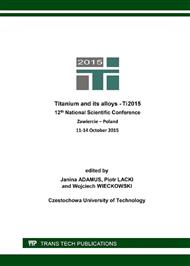[1]
Z.G. Wang, Tribological approaches for green metal forming, J. Mater. Process. Tech. 151 (2004) 223–227.
Google Scholar
[2]
R. Hernández Battez, J.L. González, J. E. Viesca, J. M Fernández, A. Díaz Fernández, R. Machado, R. Chou, and J. Riba, CuO, ZrO2 and ZnO nanoparticles as antiwear additive in oil lubricants, Wear 265/3-4 (2008) 422–428.
DOI: 10.1016/j.wear.2007.11.013
Google Scholar
[3]
Z.S. Hu, J.X. Dong, G. X Chen, Study on antiwear and reducing friction additive of nanometer ferric oxide, Tribol. Int. 31 (1998) 355–360.
DOI: 10.1016/s0301-679x(98)00042-5
Google Scholar
[4]
M. Mosleh, N.D. Atnafu, J.H. Belk, O.M. Nobles, Modification of sheet metal forming fluids with dispersed nanoparticles for improved lubrication, Wear 267 (2009) 1220–1225.
DOI: 10.1016/j.wear.2008.12.074
Google Scholar
[5]
L. Rapoport, Y. Feldman, M. Homyonfer, H. Cohen J. Sloan, J.L. Hutchison, R. Tenne, Inorganic fullerene-like material as additives to lubricants: structure–function relationship, Wear 225–229 (1999) 975–982.
DOI: 10.1016/s0043-1648(99)00040-x
Google Scholar
[6]
Y.Y. Wu, W.C. Tsui, T.C. Liu, Experimental analysis of tribological properties of lubricating oils with nanoparticle additives, Wear 260 (2007) 819–825.
DOI: 10.1016/j.wear.2006.08.021
Google Scholar
[7]
F. Chinas-Castillo, H.A. Spikes, Mechanism of action of colloidal solid dispersions, Transaction of the ASME. 125 (2003), 552–557.
DOI: 10.1115/1.1537752
Google Scholar
[8]
A. Kiechle, Entwicklung umweltfreundlicherer Kuhlschmierstoffe fur die Umformung von Blechen. Werkstattstechnik. 79/10 (1989) 577-580.
Google Scholar
[9]
A. Määttä, P. Vuoristo, T. Mäntylä, Friction and adhesion of stain-less steel strip against tool steels in unlubricated sliding with high contact load, Tribol. Int. 34 (2001) 779–786.
DOI: 10.1016/s0301-679x(01)00074-3
Google Scholar
[10]
J. Adamus, J.M. Lackner, Ł. Major, A study of the impact of anti-adhesive coatings on the sheet-titanium forming processes, Arch. Civ. Mech. Eng. 13 (2013) 64–71.
DOI: 10.1016/j.acme.2012.12.003
Google Scholar
[11]
Z.G. Wang, Tribological approaches for green metal forming, J. Mater. Process. Tech. 151 (2004) 223–227.
Google Scholar
[12]
M. Balulescu, L. Cira, J Herdan, Environmentally friendly metal-working fluids, Ecological and Economical Aspects of Tribology, Proceedings of the 9th International Colloqium, Technische Akademie Esslinggen 11–13 January 1994, 7. 11-1–7. 11-5.
Google Scholar
[13]
P.R. Miller, H. Patel, Using complex polymeric esters as multifunc-tional replacements for chlorine and other additives in metalworking, Lubr. Eng. 53 (1997) 31–33.
Google Scholar
[14]
K. Rao, J. Wei, Performance of a new dry lubricant in the forming of aluminum alloy sheets, Wear 249 (2001) 86–93.
DOI: 10.1016/s0043-1648(01)00526-9
Google Scholar
[15]
M. Takeuch, F. Ikesue, N. Kashimura, Development of environmentally friendly lubricant with high performance and simple treatment for cold forging, Proceedings of the 6th ICTP (1999) 383–390.
Google Scholar
[16]
M. Tisza, M. Tisza Jr., Development of a Capp system for lubricating selection in sheet metal forming, Proceedings of the 7th ICTP (2002) 751–756.
Google Scholar
[17]
A.C. Carcel, D. Palomares, E. Rodilla, M.A., Evaluation of vegetable oils as pre-lube oils for stamping, Mater. Design 26 (2005) 587–593.
DOI: 10.1016/j.matdes.2004.08.010
Google Scholar
[18]
A. Erdemir, G.R. Fenske, R.A. Erck, F.A. Nicholas, D.E. Busch, Tribological properties of boric acid and boric-acid-forming surfaces, Part 1: crystal chemistry and mechanism of selflubrication of boric acid, Lubr. Eng. 47 (1991) 168–178.
DOI: 10.1016/b978-1-85166-813-7.50063-2
Google Scholar
[19]
A. Erdemir, Tribological properties of boric acid and boric-acid-forming surfaces, Part II: mechanisms of formation and self-lubrication films on boron- and boric oxide-containing surfaces, Lubr. Eng. 47 (1991) 179–183.
DOI: 10.1016/b978-1-85166-813-7.50063-2
Google Scholar
[20]
H. Liang, H. S. Jahanmir, Boric acid as an additive for core-drilling of alumina, J. Tribol. 117 (1995) 65–73.
DOI: 10.1115/1.2830608
Google Scholar
[21]
M. Lovell, C.F. Higgs, P. Deshmukh, A. Mobley, Increasing formability in sheet metal stamping operations using environmentally friendly lubricants, J. Mater. Process. Tech. 177 (2006) 87–90.
DOI: 10.1016/j.jmatprotec.2006.04.045
Google Scholar
[22]
K.P. Rao, C.L. Xie, A comparative study on the performance of boric acid with several conventional lubricants in metal forming processes, Tribol. Int. 39 (2006) 663–668.
DOI: 10.1016/j.triboint.2005.05.004
Google Scholar
[23]
A. Erdemir, O.L. Eryilmaz, G.R. , Self-replenishing solid lubricant films on boron carbide, Surf. Eng. 15 (1999) 291–295.
DOI: 10.1179/026708499101516605
Google Scholar
[24]
A. Gåård, P. Krakhmalev, J. Bergström, Influence of tool steel microstructure on origin of galling initiation and wear mechanisms under dry sliding against a carbon steel sheet, Wear 267 (2009) 387–393.
DOI: 10.1016/j.wear.2008.11.013
Google Scholar
[25]
J. Adamus, Analysis of forming titanium products by cold metal forming. Czestochowa University of Technology Publishing House, Monographs Series No 174, Czestochowa, Poland 2010 (in Polish).
DOI: 10.17580/cisisr.2020.01.08
Google Scholar
[26]
J. Adamus, Stamping of the Titanium Sheets. Key Eng. Mat. 410-411 (2009) 279-288.
DOI: 10.4028/www.scientific.net/kem.410-411.279
Google Scholar
[27]
J. Adamus, Lubrication in sheet metal forming, Proceedings of the 12th International Colloquium: TRIBOLOGY 2000 – Plus, Technische Akademie Esslingen, Germany, (2000).
DOI: 10.1108/ilt.2000.01852bac.002
Google Scholar
[28]
K. Dyja, Tribological aspects in forming sheets used in aviation (in Polish) Lublin University of Technology Publishing House, Lublin, Poland, (2015).
Google Scholar
[29]
J. Adamus, W. Więckowski, K. Dyja, J. Podlewski, Patent application no P. 409887 dated 21. 10. (2014).
Google Scholar


